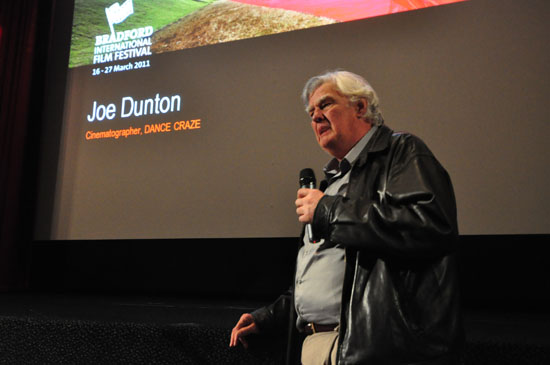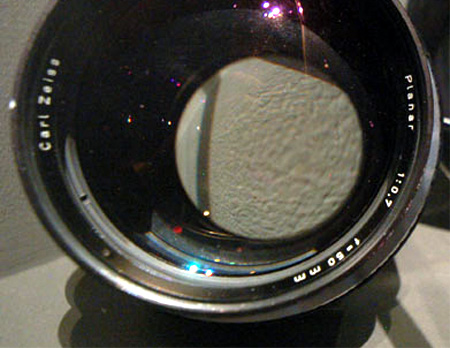Sir Sydney Samuelson and Real Picture Quality | Read more at in70mm.com The 70mm Newsletter |
| Interviewed by: Thomas Hauerslev. Transcribed for in70mm.com by Brian Guckian. Proofread by Sir Sydney Samuelson and Mark Lyndon for accuracy. Images by Thomas Hauerslev, unless otherwise noted | Date: 26.08.2013 |
Stanley Kubrick | |
|
TH: OK, let’s devote the last 15 minutes to
say, Stanley Kubrick...shooting "2001" on 65mm, and the challenges – Sir Sydney: Well, with Panavision came a lot of huge business benefits. It introduced us to the biggest filmmakers in the world – anyone who was going to make a movie in Europe –and they were in the budget class that they would like to use Panavision as a matter of course. They would all come to us. The first deal we discussed was when Bob Gottschalk didn’t even deign to tell me what the financial split deal would be if we handled Panavision in Britain. So all these Cameramen – do you know about James Wong Howe? – he came once to Samuelson’s in Cricklewood Broadway and I showed him around – I forget what picture he was going to do – I don’t think it was in the UK, it was in Germany or somewhere like that. And he appreciated what he saw; he loved all the staff people who were so enthusiastic about what they did, even if they were just checking out tripods. They loved being in our business – I think I can say that, without exaggerating. And when he was leaving – we had just brought out what we call a Limpet mount, a big “sucker” you applied to any shiny surface: pane of glass, window, tiles – and it had a camera head on it, so you could stick it on the side of a car, we’ll say, and mount your camera there; and it had a ball head on it – we called it the “Samuelson Limpet Mount”. Everybody now has limpets I should think, every Camera Supplier’s now has limpets – but ours was the first, and my brother David had worked it out and found a supplier of large – I should think about 8-inch – rubber limpets, each with a lever handle affixed. We also made up a wooden platform, about 12 inches square, and mounted on it this limpet mount. We had plate glass front doors to the company and we mounted it on them, about a foot off the ground. Jimmy Wong Howe stood on our Limpet Mount with his arms folded like this [Gestures]. We would never have got people of that calibre to our company without Panavision’s name attached to ours. Now of course Stanley Kubrick came on our scene.  Joe
Dunton in Bradford, 2011 Joe
Dunton in Bradford, 2011I think I might say there was mutual dislike between Panavision’s Gottschalk and Stanley Kubrick, who was uncompromising in any way, and knew better than anybody. And most of what he felt he knew better, he did know better – but was a bit nutty with it! Difficult...my word! And if he could possibly avoid using Panavision, he would. And that was why Bob – part of his personality was he wouldn’t lower himself to say, “I saw the latest Kubrick picture, it was very well shot”. Bob, with his kind of personality, couldn’t do that – I could do it, even if I didn’t like the bloke, I could still say, “But my goodness what a marvellous movie”. But Bob couldn’t – he would say, “Oh it’s nothing special”. Then, "2001: A Space Odyssey" came up. And Kubrick and I had become quite good friends. But he had collected equipment of his own and therefore he only ever came to see me if there anything new coming along that he didn’t know about. But it was only at his convenience; if there was something he wanted, and we were the only place he could see it, then he would come to us. We never had a row. He never disagreed about paying his bills, or anything like that. He was never a “good” customer. He and Joe Dunton were very close friends. Joe is a fantastic techie as you know, marvellous engineer, knows a great deal about cinematography, every aspect of it – special effects, anything you want to talk about – and he runs a very good camera company. He was pirated away from us by our major competitor, who hadn’t got a Camera Department. Kubrick would only ever come to see us at night. He was a bit strange – you know his home in Borehamwood was like a fortress, and I don’t know if he actually had live guards – it’s nothing unusual to have security rooms in America, and live security guards for these celebrities – very, very wealthy people. I understand that you couldn't just walk up to his front door and ring the bell – and that’s only local, in Borehamwood, 5 miles away – but he would only come to Cricklewood in the evening. So to meet Stanley, I would have to hang around at the Office, and then he would stay a couple of hours and he would look at anything we’d had that was new. He would then, if he could, go out and buy it. We never did a picture for him, except "2001", and that was because he hadn’t got 65mm gear of his own. He took Panavision equipment on sufferance – I bet he and Bob did not discuss anything at any time about the film – he would have dealt with Bob’s staff rather than meet him; I think I could be pretty sure of that. And, for "2001" Stanley said, “I shall want the equipment for about four weeks beforehand, and I shall want alternative lenses at each focal length. And I will choose which I’m going to use”. That meant equipment was going to be supplied through us. Now you would expect to supply the equipment free of charge for a week – that’s enough time – normally! – to check out all the lenses, all the focus scales, everything; every kind of check that you want to make. But Stanley wanted it for four weeks. And I suppose Bob – nobody moves in Panavision without Bob’s approval – I suppose Bob approved: “Well, it would still be good to have a Stanley Kubrick picture...whatever kind of a sod he is, it will be prestigious to have a Stanley Kubrick picture...shot in Panavision 65mm”. And the Cameraman was one of the greatest British Cameramen of all time...that was Geoff Unsworth – what a lovely man. Anyway, this is what Stanley did: he had a set built, and built into the set was a lens focus chart – I think it was about that size [Gestures]. And also, a television monitor. And at the end of the wire, feeding that television monitor, was a video camera with a pack shot lens on it, one that would focus down to about two inches of the lens scale. And then he would have two smaller focus boards at different distances from the main focus board, so that he could measure the depth of field. One say 3 feet behind, and one 3 feet in front, or maybe 2 feet in front. So on the monitor he had a picture of where the setting on the lens scale was. When he saw the rushes he could see which focus setting looked best, knowing that the correct focus would be 8 feet – we’ll say. And he could see if it was absolutely, as they say, “on the money”: the main focus board, pin-sharp at 8 feet, and the depth of field for the two other focus boards. |
CHAPTERS • Home: A Conversation with Sir Sydney Samuelson • Cinema was always in my Family • Panavision, Bob Gottschalk and The Answering Machine • Dickie Dickenson, David Lean and British Quota Film • Stanley, Joe and "2001: A Space Odyssey" • Takuo Miyagishima, Robert Gottschalk and a 20:1 Zoom • David Lean and The Friese-Greene Award • Thunderball, Zhivago, Techniscope, and Fogging a roll of film • Ken Annakin, "Grand Prix", James Bond, Helicopters • How lucky can you be More in 70mm reading: • The Importance of Panavision • A Message from Freddie A. Young • Stanley Kubrick • Shooting "Lawrence of Arabia" • Memories of Ryan's Daughter • Joe Dunton • Ken Annakin • 70mm in London 1958 - 2012 • The editor Receives BKSTS award Internet link: • George Berthold "Bertie" Samuelson (1889 - 1947) (PDF) • Samuelson Film Service (reunion) • samuelson.la • The Argus • British Film Industry Salute • Wikipedia YouTube/Vimeo • 'Strictly Sydney' • Clapper Board Part 1 • Clapper Board Part 2 • St. Mary's 1963 |
 Carl
Zeiss' 50mm 1:0,7 Planar Carl
Zeiss' 50mm 1:0,7 PlanarBut then, he would do perhaps four other tests on the same lens, everything the same, but with a different setting on the focus. So he would go say, to 8 feet 6, and even, 9 feet, and then he’d go to 7 foot 3 and 7 foot 6 and photograph all those. So you could see actually whether the lens was sharper. If it wasn’t – in other words, if the scale on the lens, engraved on the lens, was marked up absolutely pin-sharp on the number – that’s why he wanted them for four weeks, just for testing. Anyway, with the obvious approval of Geoff Unsworth, the Assistant – who became an Oscar-winning Cameraman – lit some pictures for Stanley later. Really an Arriflex man, John Alcott, BSC was an Assistant at that time, but was given a break by Kubrick because of course Kubrick was a Cameraman himself. And I remember that film, it was "Barry Lyndon", an 18th-century period piece – and Stanley Kubrick was determined to photograph a candle-lit scene where the light of the actual candles was the only illuminant. And he’d found one or two or three f1, yes f1, lenses! And the artists had to do everything without moving, forwards or backwards even an inch, because there was no depth of field at all! But it was at f1 – Kubrick liked that! Anyway, that’s how we came to do "2001". It became an iconic film. Many people have said, who are not necessarily technicians, “Oh, what a boring film”. But of course the music was also so important to that film, for which Stanley paid nothing, when you come to think of it! But he was such a clever man... I’m not in favour of everything that he did, like "Clockwork Orange" – that’s not Cinema for me. But then, I’m really old-fashioned. And when I do movie quizzes sometimes – and I have a movie quiz that will confirm what I just said – I've got a reel of ten clips where I say, “To be sexy, you don’t have to be explicit”. Is explicit a good word for you? I've got ten clips where you see absolutely nothing at all. And I suppose my favourite one is from that film "Tom Jones" - the eating scene – do you know the one where they’re – TH: I haven’t seen the film in many, many years...is that the one with Albert Finney? | |
"Tom Jones" and one point | |
 Sir Sydney: Yes, Albert Finney and Joyce
Redman – and all it is, is the couple absolutely – Sir Sydney: Yes, Albert Finney and Joyce
Redman – and all it is, is the couple absolutely – would obviously prefer to be in bed together, but they’re nevertheless sitting in like, a pub restaurant. And they’ve got chicken – legs of chicken...and lobster – and all it is, is when he’s eating the chicken – he’s not thinking about what he’s eating, he’s thinking about what’s she going to be like in bed! [Laughs] And the same looks from her...there’s no dialogue, and it’s just what’s in one’s mind. You’ll get it out of the library and have a look at it – it’s interesting. I could talk to you about how that happened, to be the first real feature film that we serviced, shot entirely with an Arriflex. When we got the new-fangled blimped Arriflex – which was never very good for keeping the noise in, because, as my brother David puts it, the trouble with an Arriflex is you can’t blimp a noisy camera – you’ve got to design a quiet camera and then blimp that. And the Arriflex un-blimped sounded like a coffee grinder to start off with! I must just quickly tell you about the producers of that movie, they were good friends, a company called Woodfall. Not low budget, but they didn’t waste any money, I can tell you – we used to service their pictures and we were really good friends. They came to see me and said, “Normally we get the Mitchell from the studio – tell us about the new blimp you’ve got – is it right you can use an Arriflex? We could shoot our next picture, "Tom Jones", on an Arriflex?” I said, “Well you could, and the blimp is quite good, but it would be good if it’s in the Winter, so that everyone could take their coats off and throw them over the blimp to try and keep that last bit of noise in there!” And I said, “You’ve also got to keep in mind that you have to re-load every four minutes instead of every ten minutes, so if you’re in the middle of a dialogue scene you’re liable to have someone shouting ‘Camera needs re–loading!’ That’s going to happen two-and-a-half times more often than using a Mitchell – expensive”. Anyway they said, “Well what we would like to do is, you supply us with the new Arriflex and everything else of course, but we don’t want you to Invoice us, we’re going to give you 1% – we’re going to give you 1 point”. I said, “What does that mean?” “1% of the profit of the picture”. When I usually tell this story Thomas, I haven’t usually revealed it’s "Tom Jones" – which became best Oscar–winning picture of the year! And must have made an absolute bloody fortune. And I tell that story because I think it’s the worst business decision I ever made! I remember saying to Leigh Aman, the Production Controller, I said, “Leigh, I understand what you’re saying – I don’t invoice, but I’ve got one point – meanwhile, how do I pay my hire purchase? Every month I’ve got to pay the hire purchase payment because I wouldn’t be able to go buy that blimped Arriflex for cash, the whole thing – I’ve got a hire purchase payment on it, and I have to pay every month! How do I do that if I don’t invoice?” And he said, “Yeah, that would be a problem”. And at the end of it they did say to us, “We found some money so we will be able to pay your bills every two weeks as usual”. And they did, but I didn’t have the 1%! [Laughs] TH: Thank you very much – I want to thank you of course for taking the time out. It’s been so interesting, and I’m sure we can talk a lot more. Sir Sydney: Well I hope you’ll come back! TH: Let’s consider this the beginning! | |
Part Two – Monday 28 January 2012 | |
|
TH: Yes – now it’s Saturday 28th January
2012...As I wrote in my notes last time we parted...We ended up talking
about Stanley Kubrick and "2001: A Space Odyssey", and his need for
having the cameras for four weeks rather than one week I think, to test
them, particularly the lenses. Sir Sydney: That’s right...and did we go into the way he did his lens tests? TH: We did that – with the cameras and three feet and the depth of field, and all these things with the lenses... and then we continued and you talked about John Alcott, and we proceeded to "Barry Lyndon", where some sequences were filmed only with actual candlelight. Sir Sydney: He found an f1 lens...the actors had to have a steady out-of-sight piece of wood behind them to keep their head at the right distance because there was no depth of field at f1 at all.  Jan
Jacobsen with his own 3D rig and Arriflex cameras captured by Gerhard
Fromm's camera Jan
Jacobsen with his own 3D rig and Arriflex cameras captured by Gerhard
Fromm's cameraTH: I heard somewhere that he knew about a Norwegian lens designer – Jan Jacobsen – Do you recall this name? Jan Jacobsen? Sir Sydney: No – TH: He was a wizard making cameras – he built the first IMAX camera. Sir Sydney: Really? In Canada? TH: No no, he built it in Copenhagen actually. Sir Sydney: Amazing! TH: Yes, on my website there is the full story about Jan Jacobsen, written by Gerhard Fromm, who I interviewed – because Gerhard Fromm has a history with MCS 70, the West German 70mm format they made in ’62 – But Jan made the cameras for MCS 70 and IMAX, and he was a wizard – and he also worked for Arriflex making their zoom lenses – anamorphic zoom lenses. What he did was he put the anamorphics behind the lens so you could zoom – before that you couldn’t make as I understand, anamorphic zoom lenses. Sir Sydney: You don’t know about what year we’re talking about? TH: This is the early ´60s - Sir Sydney: Early ‘60s...yes...because Panavision zoom lenses – anamorphic zoom lenses – were mostly based on the Cooke 5 to 1 high quality zoom. I think it was 20-100mm – that was the lens on which Panavision based their zoom lens. Of course it became 40-200mm in focal length when they’d made it anamorphic – and as I understood it, although Bob Gottschalk was very secretive (even to me) on that – he never talked to me about it – I’m pretty sure the anamorphic elements were all made in Japan. And that’s how Panavision was able to bring out, early on, a good-quality anamorphic zoom lens, based on the Cooke 5 to 1. A lot of the Panavision prime – the prime part of their lenses – from since almost the start of Panavision, Inc., were based on Cooke lenses after maximum testing. But then, later, just after Bob died, the executive (Jac Holzman) who took over, who had come from Warner Bros – Warner Bros by that time owned Panavision – he went to Leitz in Canada, and they designed a series of prime lenses, only for Panavision. They must have been to Panavision’s specification – and I forget what they’re called, but it’s something like Super Panalux – but they were excellent spherical lenses – excellent. And I think they were all made by Leitz, Canada. And so you could book a Panaflex camera and book say, six lenses, and they’d all have the same technical background. And that overcame the problem that you had with the use of lenses from different sources, because it wasn’t only the quality say of the definition – the focus, the contrast – you had to deal with the colour temperature. And so you could have two lenses, say one was from Cooke and one was from Zeiss – and they’d both be very good lenses. But if you used them on a movie, and took one lens off and changed it for a focal length of a different make, when you saw the rushes there was maybe a blue bias on one of the lenses, and a yellow bias on the other – I don’t mean heavy colour, but you had to depend on your grader, in post-production, to sort out where different lenses had been used. Well, having this set of Leitz lenses I think solved that problem. What the story is of the original optics today I really don’t know. TH: I just heard it many years ago that Jan Jacobsen made this extremely fast lens that NASA used for taking pictures in outer space or something, and Stanley Kubrick got hold of one of these lenses somehow, and then he could make the film as he intended to do, in candlelight, because in those days (the period of the picture) there were no electric lights – so everything had to be lit according to how it was in 17-hundred-and-something, when the story of Barry Lyndon takes place. I just heard the story about Stanley Kubrick and Jan Jacobsen, so it would be interesting if you could actually connect the story – if you knew about that – Sir Sydney: No...I didn’t know about that - I have got a story about "Barry Lyndon"...Kubrick – who hardly ever went anywhere – he never socialised at all; he hardly left his home – he had a paranoia about security...he lived in Borehamwood – Elstree – about 15 miles from here. He never went anywhere abroad, because he wouldn’t fly – he had a fear of flying – and so once he’d come here, he stayed here! And as far as I know, he never went back to America; he never went to any awards ceremonies; he never gave interviews, as far as I know – people would talk about him; people worked with him; but I don’t think he wanted to be publicised in any respect. | |
|
• Go to next chapter:
Dickie
Dickenson, David Lean and British Quota Film • Go to previous chapter: Panavision, Bob Gottschalk and The Answering Machine • Go to full text: Sir Sydney Samuelson and Real Picture Quality • Go to home page: A Conversation with Sir Sydney Samuelson | |
| Go: back - top - back issues - news index Updated 22-01-25 |
